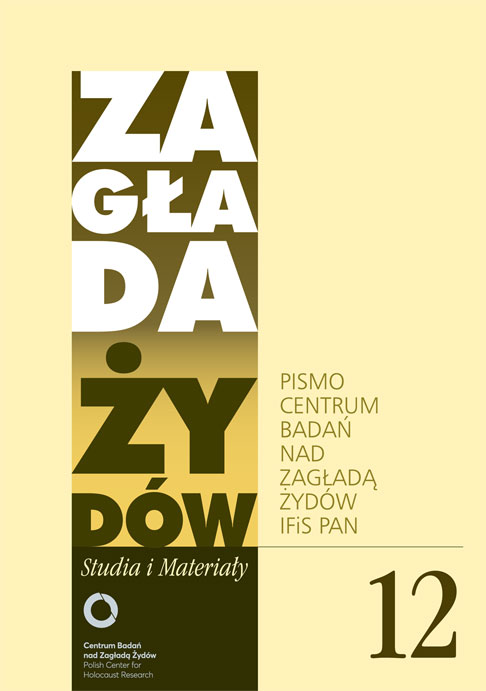Społeczeństwo holenderskie i los Żydów: skomplikowana historia
Zagłada Żydów. Studia i Materiały, Nr 12 (2016), Strony: 425-434
Data zgłoszenia: 2020-10-20Data publikacji: 2016-11-30
 https://doi.org/10.32927/ZZSiM.426
https://doi.org/10.32927/ZZSiM.426
Abstrakt
The percentage of victimization of Dutch Jewry during the Shoah is the highest of Western, Central and Southern Europe (except, perhaps of Greece), and close to the Polish one: 75%, more than 104.000 souls. The question of disproportion between the apparent favorable status of the Jews in society – they had acquired emancipation in 1796 - and the disastrous outcome of the Nazi occupation as compared to other countries in general and Western European in particular has haunted Dutch historiography of the Shoah. Who should be blamed for that outcome: the perpetrators, i.e. the Germans, the bystanders, i.e. the Dutch or the victims, i.e. the Dutch Jews? The article first surveys the answers given to this question since the beginnings of Dutch Holocaust historiography in the immediate post-war period until the debates of today and the factors that influenced the shaping of some basic perceptions on “Dutch society and the Jews”. It then proceeds to detailing several facts from the Holocaust period that are essential for an evaluation of gentile attitudes. The article concludes with the observation that – in spite of ongoing debates – the overall picture which has accumulated after decades of research will not essentially being altered. Although the Holocaust was initiated, planned and carried out from Berlin, and although a considerable number of Dutchmen helped and hid Jews and the majority definitely despised the Germans, considerable parts of Dutch society contributed to the disastrous outcome of the Jewish lot in the Netherlands – through a high amount of servility towards the German authorities, through indifference when Jewish fellow-citizens were persecuted, through economically benefiting from the persecution and from the disappearance of Jewish neighbors, and through actual collaboration (stemming from a variety of reasons). Consequently, the picture of the Holocaust in the Netherlands is multi-dimensional, but altogether puzzling and not favorable.
Słowa kluczowe
społeczeństwo holenderskie wobec Żydów , literatura o Zagładzie w Holandii
Licencja
Prawa autorskie (c) 2016 Autor&"Zagłada Żydów. Studia i Materiały"

Utwór dostępny jest na licencji Creative Commons Uznanie autorstwa 4.0 Międzynarodowe.
https://creativecommons.org/licenses/by/4.0
Czasopismo publikowane jest w standardzie Diamond Open Access na licencji CC-BY-4.0 Deed - Uznanie autorstwa 4.0 Międzynarodowa - Creative Commons
Inne teksty tego samego autora
- Avner Shalev, Dan Michman, David Silberklang, Ścisła pamięć o Zagładzie w Muzeum Historii Holokaustu w Yad Vashem. Odpowiedź na artykuł Amosa Goldberga , Zagłada Żydów. Studia i Materiały: Nr 7 (2011)
Podobne artykuły
- Alina Skibinska, „Przygody niebezpieczne i męczarnie”. Relacje dwóch kobiet o tym, jak przeżyły Zagładę na terenie powiatu biłgorajskiego w dystrykcie lubelskim , Zagłada Żydów. Studia i Materiały: Nr 20 (2024)
- Aleksandra Bańkowska, Partyzantka polska lat 1942–1944 w relacjach żydowskich , Zagłada Żydów. Studia i Materiały: Nr 1 (2005)
- Jan Grabowski, Biedni Polacy patrzą na warszawskich Żydów i na getto warszawskie , Zagłada Żydów. Studia i Materiały: Nr 10 (2014)
- Anna Bikont, „Marzeniem pana Poteraja jak i moim jest, aby te niechlubne wydarzenia zostały opisane”. O zbrodni oddziału AK na Żydach ukrywających się na bagnach koło wsi Podosie w Łomżyńskiem , Zagłada Żydów. Studia i Materiały: Nr 18 (2022)
- Tadeusz Paweł Rutkowski, Kierunki, cele i rezultaty działań Służby Bezpieczeństwa PRL wobec Żydowskiego Instytutu Historycznego (1961–1970) , Zagłada Żydów. Studia i Materiały: Nr 13 (2017)
- Krzysztof Bielawski, „Nawet umarłym nie dali spokoju”. Destrukcja cmentarzy żydowskich na terenach obecnej Polski w latach 1933–1945 , Zagłada Żydów. Studia i Materiały: Nr 15 (2019)
- Barbara Engelking, Notes by Jan Górnicki (Ber Oszer Weisbaum) , Zagłada Żydów. Studia i Materiały: Nr Holocaust Studies and Materials (2013)
- Karolina Ożóg, „Życie moje zacznie się od tego dnia, kiedy pisma od was otrzymam” Korespondencja Żydów ocalałych z Zagłady na terenie ZSRR i poszukujących swoich bliskich w Polsce (1944–1945) , Zagłada Żydów. Studia i Materiały: Nr 20 (2024)
- Julia Machnowska, Sprawy synagog i cmentarzy żydowskich tuż po wojnie w dokumentach Ministerstwa Administracji Publicznej , Zagłada Żydów. Studia i Materiały: Nr 15 (2019)
- Jan Grabowski, Redakcja, From the editor , Zagłada Żydów. Studia i Materiały: 2008: Holocaust Studies and Materials
<< < 1 2 3 4 5 6 7 8 9 10 11 12 13 14 15 16 17 18 19 20 21 22 23 24 25 26 27 28 29 30 31 32 33 34 35 36 37 38 39 40 41 42 43 44 45 46 47 48 49 50 > >>
Możesz również Rozpocznij zaawansowane wyszukiwanie podobieństw dla tego artykułu.
 English
English
 Język Polski
Język Polski



 https://orcid.org/0000-0001-7496-496X
https://orcid.org/0000-0001-7496-496X

